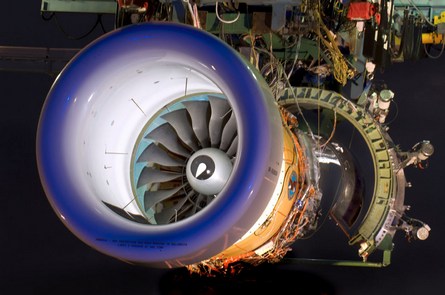Pratt & Whitney has run its Geared Turbofan (GTF) demonstrator engine on a synthetic fuel blend as part of a joint programme with NASA to compare potential emissions benefits of alternative fuels.
The GTF demonstrator was run on the 50:50 blend of conventional and synthetic jet fuel, the latter supplied by Shell and produced from natural gas using the Fischer-Tropsch process. The synthetic fuel test was conducted during recently completed Phase 1 ground testing of the GTF at P&W 's West Palm Beach, Florida engine test site.
The 130h of Phase 1 ground tests focused on demonstrating the GTF's performance over the full operating range of speeds, temperatures and pressures, says Bob Saia, vice-president next generation product family, adding that the engine met or exceeded expectations.

© Pratt & Whitney
P&W's GTF has a 3:1 reduction gearbox between the low-pressure spool and fan, allowing a larger, slower-turning fan that reduces fuel consumption and noise. The gearbox also allows the low-pressure system to run faster, improving efficiency and reducing the number of stages and blades.
"Engine starting was excellent. It started in under a minute, compared with a typical 90-120s," says Saia. Performance mapping of the three key GTF modules - fan, fan drive gear system and low-pressure compressor - produced results "within a few tenths of a percent" of P&W's analytical predictions, "in all cases better", says Saia.
Gearbox oil temperatures were slightly below predictions and noise measurements revealed no undesirable engine tones resulting from the GTF's high-speed low-pressure compressor and turbine, he says. Two fan blade designs with different root-to-tip aerodynamics were tested.
A second phase of 50-75h ground testing is planned to begin in April. For this, the GTF demonstrator will be fitted with the flight nacelle, supplied by Goodrich. Phase 2 will focus on preparing the engine for flight testing on P&W's Boeing 747SP flying testbed (FTB).
"Early in July we will fly on the FTB," says Saia. A total of 150h of flight testing is planned through to the end of the year.
P&W is working towards a formal launch of the GTF on the Mitsubishi Regional Jet by the end of March. The engine manufacturer would then begin preliminary design of the 14,000-17,000lb-thrust (62-76kN) GTF for the 70/90-seat MRJ.
Detail design would begin towards the end of 2008, with the first engine to test scheduled to run in mid-2009. Engine certification is scheduled for the first half of 2011, says Saia, with the MRJ planned to enter service in 2013.
A larger, 23,000lb-thrust version of the GTF has been selected to power Bombardier's proposed CSeries 110/130-seat airliner. Bombardier is aiming for authority to offer the CSeries in the first half of 2008, he says, with the aircraft to enter service in 2013.
Saia says P&W has also had early discussions with Embraer as well as Russian manufacturers, and continues to work closely with Airbus and Boeing as they move towards defining their next-generation single-aisle airliners.
Source: FlightGlobal.com



















